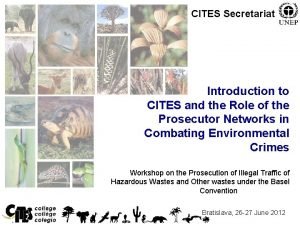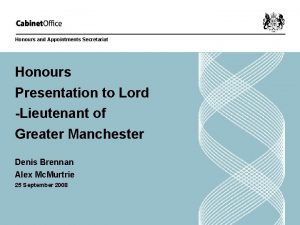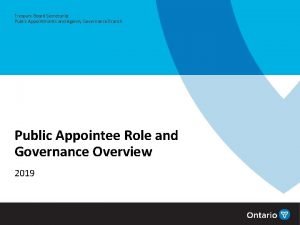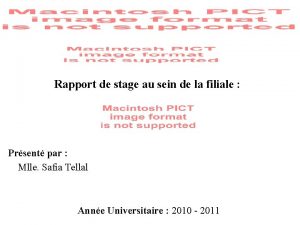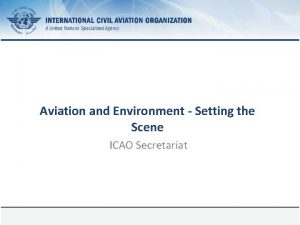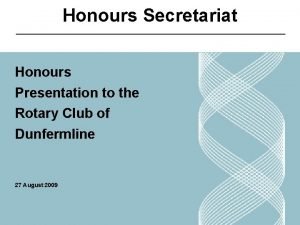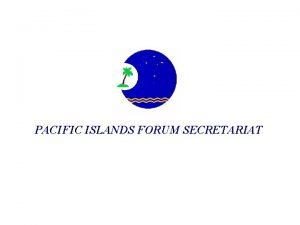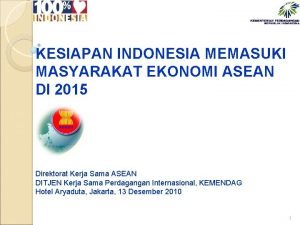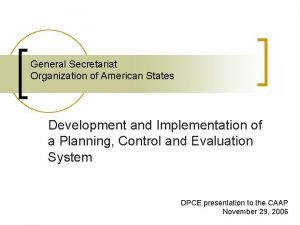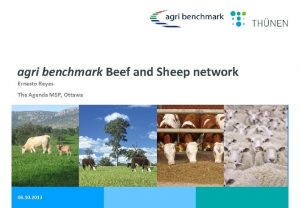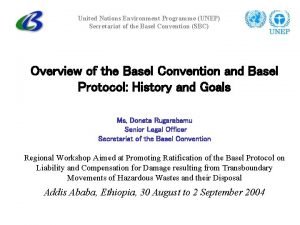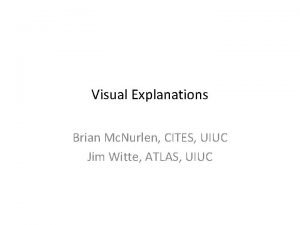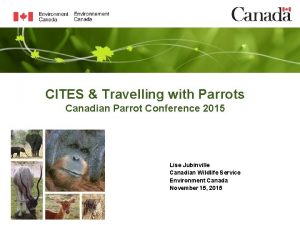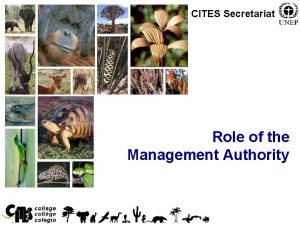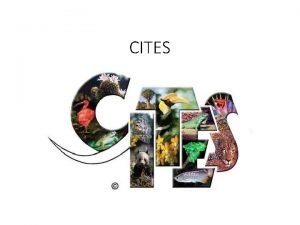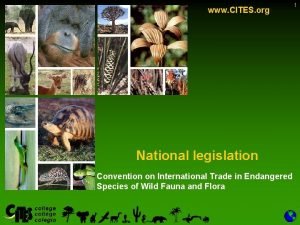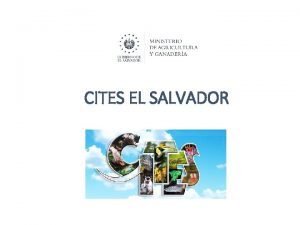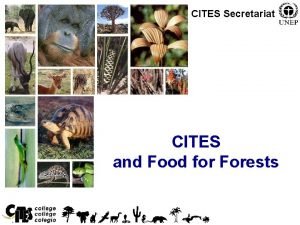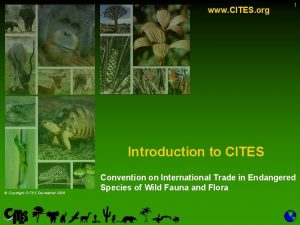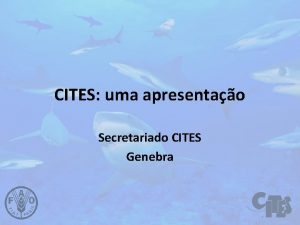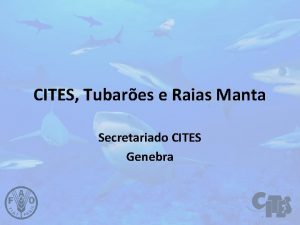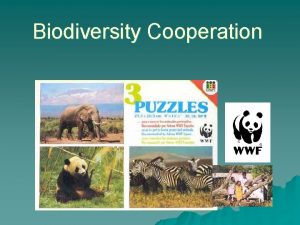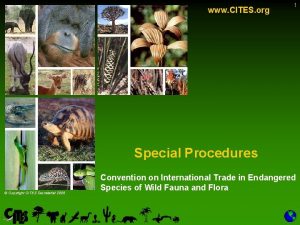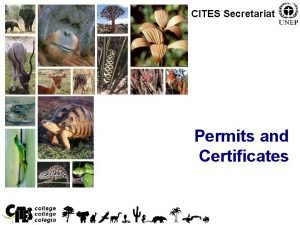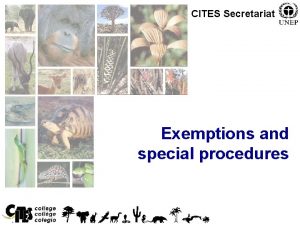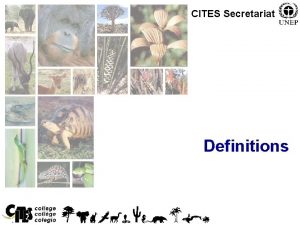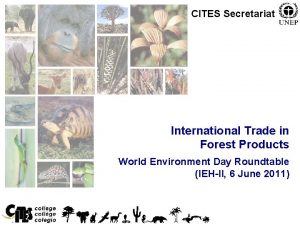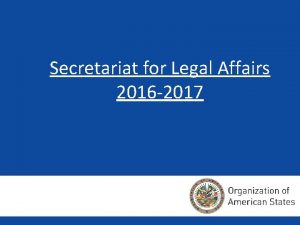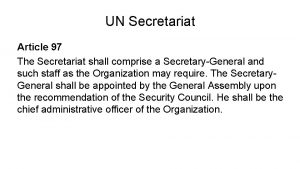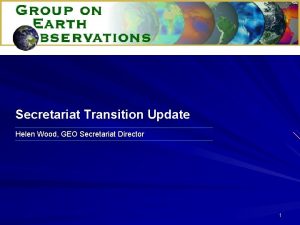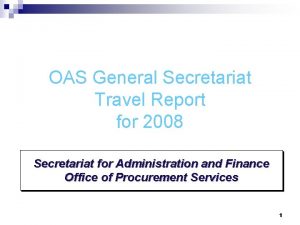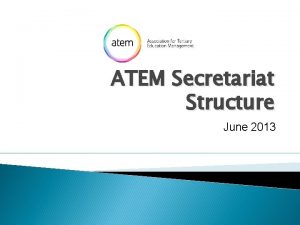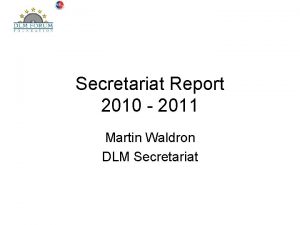CITES Secretariat Introduction to CITES and the Role

























- Slides: 25

CITES Secretariat Introduction to CITES and the Role of the Prosecutor Networks in Combating Environmental Crimes Workshop on the Prosecution of Illegal Traffic of Hazardous Wastes and Other wastes under the Basel Convention Bratislava, 26 -27 June 2012 1

2 CITES • CITES is the Convention on International Trade in Endangered Species of Wild Fauna and Flora • CITES is an international agreement between governments • CITES was signed on 3 March 1973, and entered into force on 1 July 1975 • Number of CITES Parties: 175

3 CITES • The aim of CITES is to ensure that the international trade in wild fauna and flora is legal, sustainable and traceable

4 CITES • The Convention establishes an international legal framework together with common procedural mechanisms for the general prohibition of international commercial trade in species threatened with extinction and for an effective regulation of international trade in species not now threatened with extinction

5 CITES Appendices • Species subject to CITES regulation are divided amongst three Appendices I II III "Species" means any species, subspecies, or geographically separate population thereof

6 CITES Appendices Appendix I – Species threatened with extinction, which are or may be affected by trade (3%) – International (commercial) trade in wild-taken specimens is generally prohibited – International trade for other purposes authorized only in exceptional circumstances

7 CITES Appendices Appendix II - Species not necessarily threatened with extinction, but for which trade must be controlled to avoid their becoming so (92%) – International trade for all purposes is permitted but regulated

8 CITES Appendices Appendix III – Species for which a country is asking Parties to help with its protection (5%) – International trade is permitted but regulated (less restrictive than Appendix II) » 160 animal species and 10 plant species

9 Parts and derivatives • All parts and derivatives are covered for species in Appendix I, and for animal species in Appendix III Animal parts Always covered and derivatives Covered if specified Plant parts and Always covered derivatives Covered if specified • Annotations to the listings for plants in Appendix II, and for Appendix III species, indicate which parts and derivatives are covered (The Parties have agreed that for plant species included in Appendix II, the absence of an annotation relating to that species indicates that all readily recognizable parts and derivatives are covered)

10 CITES Permits and Certificates • CITES regulates the export, re-export, import and introduction from the sea of live and dead animals and plants and their parts and derivatives (listed species only) through a system of permits and certificates • These permits or certificates may only be issued if certain conditions are met and which must be presented when leaving or entering a country • For Appendix I and II species, the most important conditions are legal acquisition and that international trade must not be detrimental to their survival in the wild (scientific advice prior to the issuance of CITES documents)

11 Collaboration and cooperation • Collaboration and cooperation at the national level are essential for CITES implementation – CITES Authorities – Resource sectors – Customs – Police – Judiciary – Affected stakeholders, including the private sector

12 CITES Structure Conference of the Parties Recommendations Scientific Authority Guidance Management Authority Officers in charge of implementing CITES Permanent Committees Secretariat Other MEAs UNEP-WCMC WCO ICPO-Interpol ITTO, FAO IUCN Other IGOs NGOs Private sector

13 Trade with non-Parties • Where export or re-export is to, or import is from, a non-Party, comparable documentation issued by the competent authorities which substantially conforms with CITES requirements for permits and certificates may be accepted • Parties accept documentation from States not party to the Convention only if the details of the competent authorities and scientific institutions of such States are included in the online CITES Directory • This also applies to specimens in transit destined for or coming from non-Parties

14 Legal and Illegal Trade • Legal ü Sustainable, traceable and can be beneficial for conservation of wild species, and for livelihoods • Illegal ü Can pose a serious risk to the conservation of wild species, significantly impacting the biological integrity of the planet ü Deprives local people of development opportunities and governments of potential revenue

15 Features of Illegal Trade in Wildlife • A well-established structured network • International borders are becoming increasingly insignificant • High profits (Illegal trade in wildlife crime estimated by some to be worth up to USD 10 billion per year) • Low risk of detection • Low penalties when apprehended

16 Features of Illegal Trade in Wildlife • Use of threat of violence • Well-armed participants • Sophisticated forgery and alteration of permits and certificates • Often linked to multiple criminal activities, e. g. money laundering, drug trafficking, corruption and financing terrorism

17 Wildlife Crime - Transnational Organized Crime • UN Convention against Transnational Organized Crime – entry into force on September 2003 • 167 Parties • A structured group of three or more persons • Acting together with the aim of committing one or more serious crime • In order to obtain financial or material benefit • Crimes are planned and/or commited in more than one country

18 What We Need • Not just seizures • Internationally-organized prosecutions • Convictions • Strong penalties • Finding suitable and effective mechanisms to prevent illegal trade, punishing criminal acts and ensure compliance with the law • Guidance material and tools for prosecution and judiciary

19 Tools • Training course for enforcement officers and information module for prosecutors and the judiciary (CITES Virtual College) • CD-ROM on Controlled Delivery • Wildlife and Forest Crime Analytic Toolkit ICCWC) • GEF Rhino Project – forensic laboratory in South Africa - DNA analysis of forensic evidence for the prosecution of wildlife crimes

20 Some Recent Convictions for Wildlife Crime • South Africa ü 3 rhino poachers – 25 years ü 1 rhino poacher – 8 years • Thailand ü 2 tiger poachers – 5 and 4 years • Cameroon ü 4 ivory poachers – 18 months ü 1 African grey parrot poacher– 30 months

21 The Role of Prosecutors’ Networks • Identify regional priorities • Regional action plans • Harmonization of legislation (similar penalties and similar requirements to improve the use of evidence in different jurisdictions) • Increase communication-exchange of relevant information/intelligence • Coordination and collaboration in integrated investigations, actions, operations

22 The Role of Prosecutors’ Networks • Share experience on prosecution of environmental crimes for the identification of best practice (successful and unsuccessful) • Technical and logistical support • Continuously building capacity • Strengthening of public prosecution • Facilitate and strengthen coordination and cooperation between national, sub-national and regional enforcement authorities

23 ICCWC • The International Consortium on Combating Wildlife Crime (ICCWC) was established in November 2010. Its partners are: – CITES – World Customs Organization – INTERPOL – UNODC – World Bank • Aims = facilitating multi-agency cooperation, materials and tools to enhance knowledge and skills, research on the drivers and scale and value of wildlife crime and related offences and national assessments of scope of illegal wildlife trafficking and associated responses.

24 Latin American Networks • CA-WEN ü environmental authorities, police, customs and prosecutors ü wildlife trafficking • Latin American Environmental Prosecutors Network ü prosecutors ü environment in general (civil and criminal matters) ü subgroup on wildlife

25 CITES Secretariat Geneva www. cites. org
 Cites secretariat
Cites secretariat Honours and appointments secretariat
Honours and appointments secretariat Literacy and numeracy secretariat
Literacy and numeracy secretariat Institute of secretariat training and management
Institute of secretariat training and management Public appointments secretariat
Public appointments secretariat Tâches effectuées rapport de stage secrétariat
Tâches effectuées rapport de stage secrétariat Cg digital secretariat
Cg digital secretariat Icao
Icao Honours secretariat
Honours secretariat Secretariat family tree
Secretariat family tree Pacific island forum secretariat
Pacific island forum secretariat Asean secretariat
Asean secretariat General secretariat for development planning
General secretariat for development planning International meat secretariat
International meat secretariat Unep secretariat
Unep secretariat Trans kalahari corridor secretariat
Trans kalahari corridor secretariat C# azure worker role example
C# azure worker role example Uiuc cites
Uiuc cites West sussex speech and language monitoring tool
West sussex speech and language monitoring tool Cites certificate for parrots
Cites certificate for parrots Cites management authority
Cites management authority Madagarská poloopice
Madagarská poloopice Cites aanvragen
Cites aanvragen Www.cites.org
Www.cites.org Which statement cites an example of cultural diffusion?
Which statement cites an example of cultural diffusion? Role making role taking beispiele
Role making role taking beispiele
